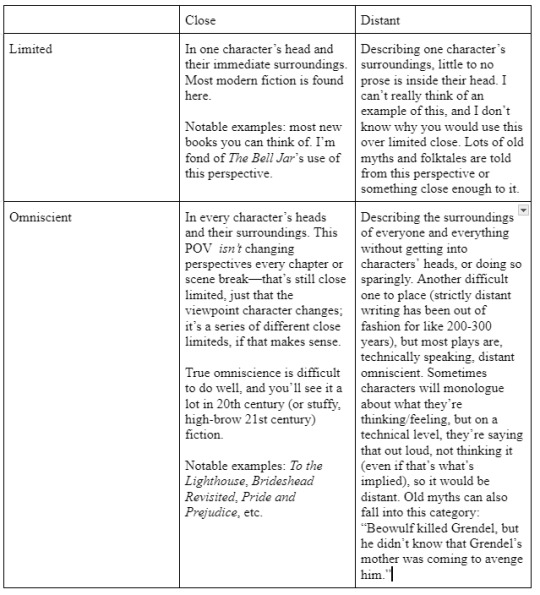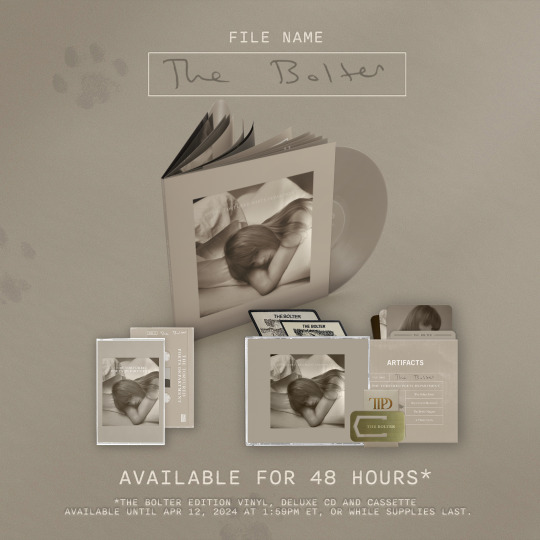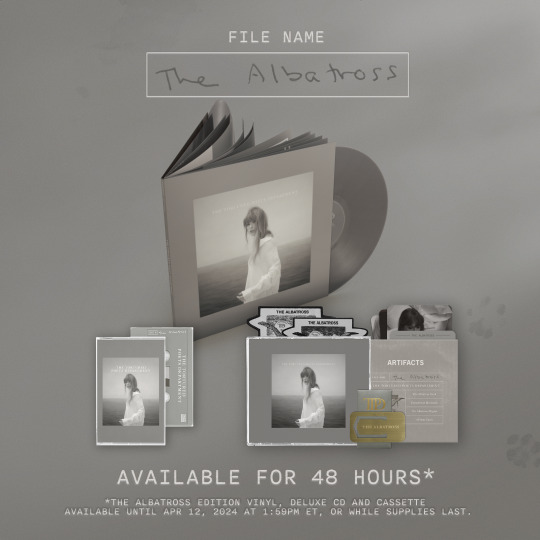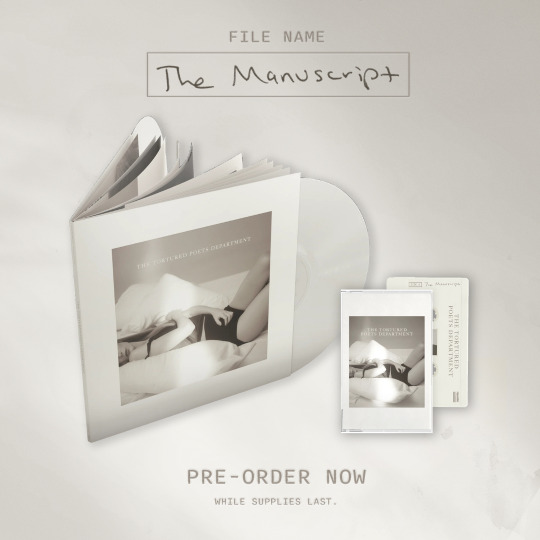Text
Get to Know Your Character
Here are some questions to consider for character development:
What parts of their childhood trigger them?
How do they treat themselves when they're feeling sad?
What parts of themselves do they tend to hide?
How do they punish themselves when they make mistakes?
Who are they loyal to? Why?
Who do they avoid? Why?
What emotions or situations do they try to avoid? Why?
What angers them?
What are their insecurities?
What are their emotional triggers?
How do they feel about love?
What are their fears?
What is their relationship with their family like?
What kind of people do they tend to gravitate towards?
What do they like/dislike about themselves?
Happy writing ❤
3K notes
·
View notes
Text
Point of View: the Biggest Thing You're Missing!
Point of view is one of the most important elements of narrative fiction, especially in our modern writing climate, but you rarely hear it seriously discussed unless you go to school for writing; rarely do help blogs or channels hit on it, and when they do, it's never as in-depth as it should be. This is my intro to POV: what you're probably missing out on right now and why it matters. There are three essential parts of POV that we'll discuss.
Person: This is the easiest part to understand and the part you probably know already. You can write in first person (I/me), second (You), and third person (He/she/they). You might hear people talk about how first person brings the reader closer to the central character, and third person keeps them further away, but this isn't true (and will be talked about in the third part of this post!) You can keep the reader at an intimate or alien distance to a character regardless of which person you write in. The only difference--and this is arguable--is that first person necessitates this intimacy where third person doesn't, but you still can create this intimacy in third person just as easily. In general, third person was the dominant (and really the only) tense until the late 19th century, and first person grew in popularity with the advent of modernism, and nowadays, many children's/YA/NA books are written in first person (though this of course doesn't mean you can't or shouldn't write those genres in the third person). Second person is the bastard child. Don't touch it, even if you think you're clever, for anything the length of a novel. Shorter experimental pieces can use it well, but for anything long, its sounds more like a gimmick than a genuine stylistic choice.
Viewpoint Character: This is a simple idea that's difficult in practice. Ask yourself who is telling your story. This is typically the main character, but it needn't be. Books like The Book Thief, The Great Gatsby, Rebecca, Dr. Jekyll and Mr. Hyde, and the Sherlock series are told from the perspective of a side character who isn't of chief importance to the narrative. Your viewpoint character is this side character, the character the reader is seeing the world through, so the main character has to be described through them. This isn't a super popular narrative choice because authors usually like to write from the perspective of their most interesting character, but if you think this choice could fit your story, go for it! You can also swap viewpoint characters throughout a story! A word of warning on that: only change your viewpoint character during a scene/chapter break. Switching mid-scene without alerting the reader (and even when you do alert the reader) will cause confusion. I guarantee it.
Means of Perception; or, the Camera: This part ties the first two together. If you've ever heard people talk about an omniscient, limited, etc. narrator, this is what they mean. This part also includes the level of intimacy the reader has with the viewpoint character: are we in their heads, reading their thoughts, or are we so far away that we can only see their actions? If your story is in a limited means of perception, you only have access to your character's head, eyes, and interpretations, where an omniscient narrator sees through all characters' heads at once. (This doesn't eliminate the viewpoint character--most of your writing will still be in that character's head, but you're allowed to reach into other characters' thoughts when needed. You could also be Virginia Woolf, who does fluidly move through everyone's perspectives without a solid viewpoint character, but I would advise against this unless you really are a master of the craft.) Older novels skew towards third person omniscient narration, where contemporary novels skew towards first person limited. You also have a spectrum of "distant" and "close." If omniscient and limited are a spectrum of where the camera can swivel to, distant and close is a spectrum of how much the camera can zoom in and out. Distant only has access to the physical realities of the world and can come off as cold, and close accesses your character's (or characters', if omniscient) thoughts.
Notice how I said narration. Your means of perception dramatically effects how your story can be told! Here's a scene from one of my stories rewritten in third-person distant omniscient. The scene is a high school football game:
“Sometimes,” he said. “Not much anymore.”
“It’s not better, then?” She shivered; the wind blew in.
“A little.” His tone lifted. “I don’t know if it’ll ever be better, though.”
She placed a hand on his arm, stuttered there, and slipped her arm around his waist. “Did it help to be on your own?”
He raised an eyebrow. “You were there.”
“Yes and no.”
“And the guys, the leaders.”
“Come on,” she heckled.
“Okay, okay.” Carmen sighed. “Yeah, it helped. I don’t think—I don’t know—I’d be me if they’d fixed it all.”
She grinned. “And who might you be?”
“Oh, you know. Scared, lonely.” He fired them haphazardly, and a bout of laughter possessed him which Piper mirrored. “Impatient.”
“And that’s a good thing?”
“No.” He sat straight. “Gosh, no. But I don’t want to be like him, either.” He pointed to the field; Devon recovered a fumbled ball. “He’s never been hurt in his life.”
She met his eyes, which he pulled away. “You don’t mean that," Piper said.
“Maybe not. He’s too confident, though.”
The cloth of Carmen's uniform caved and expanded under Piper's fingers.
With distant-omniscient, we only get the bare actions of the scene: the wind blows in, Piper shivers, the cloth rises and falls, Carmen points, etc. But you can tell there's some emotional and romantic tension in the scene, so let's highlight that with a first person limited close POV:
“Sometimes,” he said. “Not much anymore.”
“It’s not better, then?” Frost spread up from her legs and filled her as if she were perforated rock, froze and expanded against herself so that any motion would disturb a world far greater than her, would drop needles through the mind’s fabric. A misplaced word would shatter her, shatter him.
“A little.” His tone lifted. “I don’t know if it’ll ever be better, though.”
She placed a hand on his arm, thought better, and slipped her arm around his waist. “Did it help to be on your own?”
He raised an eyebrow. “You were there.”
“Yes and no.”
“And the guys, the leaders.”
“Come on,” she heckled.
“Okay, okay.” Carmen sighed. “Yeah, it helped. I don’t think—I don’t know—I’d be me if they’d fixed it all.”
She grinned. “And who might you be?”
“Oh, you know. Scared, lonely.” He fired them haphazardly, and a bout of laughter possessed him which Piper mirrored. “Impatient.”
“And that’s a good thing?”
“No.” He sat straight. “Gosh, no. But I don’t want to be like him, either.” He pointed to the field; Devon recovered a fumbled ball. “He’s never been hurt in his life.”
“You don’t mean that.” She spoke like a jaded mother, spoke with some level of implied authority, and reminded herself again to stop.
“Maybe not. He’s too confident, though.”
Piper felt the cloth of his waist cave and expand under her fingers and thought: is this not confidence?
Here, we get into Piper's thoughts and physical sensations: how the frost rises up her, and how this sensation of cold is really her body expressing her nervous fears; how she "thought better" and put her arm around his waist; her thought "is this not confidence?"; and how she reminds herself not to talk like a mother. Since I was writing from the close, limited perspective of a nervous high schooler, I wrote like one. If I was writing from the same perspective but with a child or an older person, I would write like them. If you're writing from those perspectives in distant narration, however, you don't need to write with those tones but with the authorial tone of "the narrator."
This is a lot of info, so let's synthesize this into easy bullet points to remember.
Limited vs. Omniscient. Are you stuck to one character's perspective per scene or many?
Close vs. Distant. Can you read your characters' thoughts or only their external worlds? Remember: if you can read your character's thoughts, you also need to write like you are that character experiencing the story. If child, write like child; if teen, write like teen; etc.
Here's another way to look at it!

This is a confusing and complex topics, so if you have any questions, hit up my ask box, and I'll answer as best I can. The long and short of it is to understand which POV you're writing from and to ruthlessly stick to it. If you're writing in limited close, under no circumstances should you describe how a character other than your viewpoint character is feeling. Maintaining a solid POV is necessary to keeping the dream in the reader's head. Don't make them stumble by tripping up on POV!
712 notes
·
View notes
Note
how do i get my character out of the corner i wrote myself in without a dues ex machina😭
How to Not Write Yourself Into a Corner (and How to Write Yourself Out of a Corner if You’re Already In One)

One of a writer’s WORST fears is writing themself into a corner.
It’s easy to write your characters into death-defying situations…but it’s not as easy to write the actual “defying death” part.
Some writers, in their desperation to get their characters out of a bind, employ the use of a Deus Ex Machina, as mentioned by anon:
Deus Ex Machina: (Translates to "god from the machine") A plot device where a seemingly unsolvable situation is fixed by an out-of-the-blue occurrence. The term “deus ex machina” is a reference to Greek plays, when actors playing a god would literally be lowered into the scene via a machine to magically solve any situation.
Unfortunately, this plot device is often ridiculed by readers, cited as a hack-job solution for a writer out of ideas.
How do we avoid this situation, then? Here are some tips and tricks on how to not write yourself into a corner, and how to write yourself out of a corner if you’re already in one!
Note that these tips may not work for everyone, so make sure to use your own intuition as a writer— you know your story best.
1. NIP IT IN THE BUD— OUTLINES ARE KEY!
I’m sorry to all of you pantsers out there, but the key to prevent writing yourself into a corner is to already have an idea of how each scene is going to turn out; don't make a problem without making a solution! If you keep on top of your outline, you should have no worries about writing your characters into a situation they can't get out of it.
It may be easiest to jot down ideas about a couple of scenarios and then select the one that works best, especially when it comes to dire climax scenes that have a lot of moving parts.
Check out my posts below for more in-depth advice about outlining!
How to Outline
Plotting for Pansters and Pantsing for Plotters
This advice, although essential, does require a ton of foresight and time to plan…and if you’ve sought out this post, it may mean that it’s too late for preventative measures. The subsequent tips in this post are going to be for people who are already in the thick of it and need a way to save all of their writing progress.
2. FORESHADOWING IS YOUR FRIEND (AKA “CHEKHOV’S GUN YOUR WAY OUT OF THAT SHIT”)
Foreshadowing: A narrative device wherein a writer gives an advance hint of what is to come later in the story. It helps maintain believability while subverting expectations and making plot twists.
Chekhov’s Gun: A narrative device wherein a seemingly insignificant element or object in the story becomes useful later on. Sometimes used synonymously with foreshadowing, but usually refers to a specific object.
Examples of Foreshadowing/Chekhov’s guns in media:
The 1981 Quarter (Or Extra Life Quarter) in Ready Player One
“Don’t Cross the Streams” in Ghostbusters (1984)
Winchester Rifle Hanging over the Bar in Shaun of the Dead (2004)
The Rita Hayworth Poster in The Shawshank Redemption (1994)
The Water Bottle in Bullet Train (2022)
In my opinion, a Chekhov’s Gun is the more refined twin of the deus ex machina; although it may seem like it comes out of nowhere, observant readers or those who go back into the story will realize that this event was set up from the beginning.
Foreshadowing is the key to turning a deus ex machina into a Chekhov’s Gun. It’s spreading breadcrumbs to maintain believability even when unbelievable things happen.
My advice: plant a line here and there referring to the object/element that will get you out of the corner.
These lines can be about a healing potion that a character carries around to save them when they’re at the brink of death, the fact that the city they’re fighting in often suffers from sinkholes, or that a character has a seemingly useless skill.
However, haphazardly inserting foreshadowing into your story may come across as heavy-handed; make sure it aligns with the narrative beats. Particularly big Chekhov’s Guns, especially ones that “save the day," may require multiple foreshadowing elements.
It can take a lot of work to incorporate the foreshadowing smoothly, so make sure it actually saves you time in comparison to rewriting the whole scenario/plot point.
3. TAKE A BREAK
Sometimes, the solution to your problem may not come to mind because you’re too immersed into the writing process and not thinking of the bigger picture. Or maybe it might just be good old-fashioned writer’s block. Take a step back, reassess, and return with the scene properly re-evaluated. Maybe start a new book or TV show to get some inspiration, or check out one of my posts below!
How to Overcome Writer’s Block
How to Get Inspired to Write and Regain Creativity
4. ASK FOR HELP
Sometimes, it might be best to have another set of eyes on your story! A situation that may seem unsolvable to you may have an obvious solution to a writing buddy.
5. KNOW THAT SOMETIMES RE-WRITING IS NECESSARY

I know this sounds horrible. It’s something that I wouldn’t wish upon any writer.
Sometimes, however, no amount of foreshadowing can get your characters out of the debacle they’ve put themselves in. Either that, or the work that it would take to insert the foreshadowing would be more than it’d take to rewrite the scene or the plot point.
My suggestion would be to search for the last place that you didn't feel lost, and then cut out everything after that.
(NEVER DELETE MAJOR CHUNKS OF YOUR WRITING! ALWAYS CUT IT AND SAVE IT IN A SCRAP DOC—IT COULD COME IN HANDY LATER!)
Then, take the time to outline the scenario and figure out the solution to your problem beforehand. It will suck, but trust me, it'll be worth it in the end.
HOPE THIS HELPED, AND HAPPY WRITING!
1K notes
·
View notes
Text
Honestly I was so happy to see they were back in store. It’s like I was given a second chance. So of course I preordered The Black Dog, thank you very much.




We’re unsealing THE TORTURED POETS DEPARTMENT files for one last chance to pre-order your favorite special edition vinyl, deluxe CDs, and cassettes before publication on April 19. 🗃️
As the old simile goes, move swift af boi, because the special editions are available for 48 hours, and all editions have limited supply. 🤍
1K notes
·
View notes
Text
Merry Christmas

1 note
·
View note
Text
Full Norwegian-Resource Index
As many online norwegian learning resources I could find. Thanks to Reddit r/norsk for most of the links on this list. That being said, I have not used all of these sites, but as someone who is weary of online webpages and downloading malicious links, I can tell you that as far as I know, everything is safe to use!
SKAM - Norwegian teen show
LearnNoW - Online course
DinOrdbok - Online dictionary (Bilingual)
Dict - Online dictionary (Bilingual)
Naob - Online dictionary (Monolingual)
Duostories - Short stories from Duolingo
Barnebøker - Short stories for beginners
KlarTale - News site in straightforward Norwegian (beginner friendly)
NorskPrøven Example Tests - Tests of A1-B2 level
NTNU - Paper exams + answers
BliKlar - Short tests of A1-B2 level
Duolingo Forum - Grammar notes from Duolingo
Grammatikk - Free online grammar book
NyNorskBok - Online reading list
19 notes
·
View notes
Text
richard papen, probably, with chronic hypothermia, a mild case of pneumonia, and possible head trauma, bleeding, in the winter of 1984

2K notes
·
View notes
Text
The Secret History is insane. Richard just wants to know what's going on with Camilla and Charles, and Francis is just like "Oh, yeah, Camilla and Charles sleep together all the time. I thought you knew. And I've slept with Charles, and Camilla and Henry are a thing, which Charles hates, and I want to sleep with you but you won't ever get drunk enough. Anyway, want a glass of wine?"
2K notes
·
View notes
Text
We have all spoken at length about how toxic and awful the Greek class is. So here are some sweet moments where they’re actually quite cute:
- Francis putting a blanket over Richard when he falls asleep on the couch
- Charles not ignoring animals in need: rescuing a dog about to be put down and then taking in a stray cat
- Camilla proceeding to be very good to said dog. Then both twins being devastated when it died.
- Bunny writing an “I’m sorry” note to Richard then putting it with a book and mints in his mail box
- Henry taking care of Richard after he almost freezes to death, literally being so gentle and good the whole time. (I get you could argue this was part of the psychotic master plan, but this sequence is still so soft)
- “Forgive me, for all the things I did, but mostly for the ones I did not.“
- The boys being genuinely worried about Camilla when she cut her foot and all freaking out and then helping her and talking so kindly to her
- Bunny getting described as generally very patient and nice to his chihuahua-like girlfriend and calling her “sweetie” and “honey” and wanting eight kids with her, four boys and four girls. (uh, this is before he went crazy)
- Charles and Richard musing about the Greek class all living at the farmhouse together
- Henry winking at Camilla when she did a good job reading
- Bunny genuinely being able to make Henry laugh, like by triple spacing his essay
- Distressed Richard asking Camilla to tell him a story, and her talking about the only memory of her father and how she and Charles, as babies, used to squabble over a tape measurer
- The twins hosting dinner at their apartment every Sunday even though they didn’t have much.
2K notes
·
View notes
Text
TSH spoilers:
I feel like we as a fandom do not talk about Henry’s symbolism in TSH enough. Like, that dude is the literal embodiment of death, and I just think it’s so damn cool. I mean, his whole obsession with language and literature stemmed from the fact that he almost died in a car accident. And then every death we see in the book (the farmer’s, Bunny’s, and his very own) is directly at his hands. The others were accomplices, sure, but Henry’s the one who takes action every time. And in Francis’s failed suicide and Richard’s near death in the epilogue, they both see Henry, not Bunny or Charles or what have you.
Henry is not only obsessed with death, he IS death. He’s the reaper who’s friends toy with their mortality all the time through drugs and booze. The reason they all admire him is not only because of his size and stature and brilliance; it’s because he’s dangerous. If beauty is indeed terror, than he’s the most beautiful of them all. They all have the life preservation skills of a fly, so of course they love Henry. And of course his actions constantly bring them closer to danger and death.
5K notes
·
View notes
Text
How does research even work?
As you all know, one of the mantras I repeat all the time on this blog is: "Do your research!". To which some may respond with: But how?

Well, buckle up, friends! Because I tutor first semester students at my university to teach them about academic research and writing research works pretty much the same (at least for me). So here are some basic steps to take while researching:
I. Determine your prior knowledge and its gaps
Let's do a brainstorming session: What do you already know about this topic? Take it all down in your writing tool of choice. Flashcards, notebook, digital document, whatever you work well with. Organize your thoughts in a way that makes sense to you. A mindmap, columns, bullet points...
Furthermore, think about what you don't know and try to formulate specific questions. Those will help you later with your research.
II. Determine where to look for knowledge
There are several types of literature to get into: articles, monographs, anthologies... You can find access to those via your local and/or university library (if you go to uni), online archives, academic databases including google scholar, etc. Look for trustworthy, peer reviewed, established sources (especially online). You should also prioritize own voices sources when it comes to writing about a specific community or identity.
Tip: Wikipedia is not a source, but a great starting point, since it often features a bibliography with great sources.
I shall not give you specific archives/websites to use in this post, because access varies widely depending on your location and the languages you speak.
III. How to look for knowledge
Let's go back to the notes you took at the beginning: Look for keywords that relate to your topic and help you in answering your questions. Look for synonyms, hyperonyms and hyponyms to use individually and/or combined in your database.
Whenever possible use Boolean operators. Those are used in most databases to establish logical relations between your search terms, such as AND, OR and NOT.
AND: Both terms have to be present in all results
OR: either one or the other term has to be present in all results
NOT: exclude this term from the results
Usually, typing in two terms in one search field automatically constitutes an AND.
Look at the bibliographies of your results to find even more helpfull sources but be aware not to snowball into oblivion by doing this.
Good research is determined by a variety of databases, sources and keywords. Although quality is always better than quantity.
IV. Evaluate the results
Look at your results to assess and sort them by relevance to your search. You can do this by taking your list of keywords and seeing how prominent they are featured in the results. Are they in the title, in the abstract, in the table of contents? Do they seem to be very relevant in the topic of the source or are they just mentioned in a half-sentence?
How accessible is the source for you? Can you easily read it online, can you borrow it from the library, is it behind a paywall, do you have to buy it from some obscure seller? The less accessible it is, the more you have to evaluate the importance of the source. Do you really need it or can you get the information elsewhere?
Is there prominent criticism of the source, by peers, by the community it talks about (if you are doing research about a specific community or identity that is) or by yourself? Does this criticism render this source untrustworthy? How recent is the source? Is it old research, maybe even obsolete or harmfull?
Good research is determined by the critical evaluation and comparison of sources.
V. Time to read, read, read
Yes, it's at this point you actually start to read! And read. And read. And read some more. Like at the researching stage, be carefull not to snowball into the abyss while reading. Determine how relevant the topic you research is for your writing (e.g. you don't have to spend weeks researching penguins because you have a scene at the zoo) and spend time accordingly.
How you take notes and organize your research is up to you, everyone works differntly here. I, for example, do excel spreadsheets and write down WAY too much detail. Try and see what works for you.
While reading, always keep in mind to think critically, compare, cross-reference and evaluate.
Have fun researching!
520 notes
·
View notes
Text
HOW TO GIVE PERSONALITY TO A CHARACTER
Giving personality to a character is an essential part of character development in storytelling, whether you're writing a novel, screenplay, or creating a character for a role-playing game. Here are some steps and considerations to help you give personality to your character:
Understand Their Backstory:
Start by creating a detailed backstory for your character. Where were they born? What were their childhood experiences like? What significant events have shaped their life? Understanding their past can help you determine their motivations, fears, and desires.
2. Define Their Goals and Motivations:
Characters often become more interesting when they have clear goals and motivations. What does your character want? It could be something tangible like a job or a romantic relationship, or it could be an abstract desire like happiness or freedom.
3. Determine Their Strengths and Weaknesses:
No one is perfect, and characters should reflect this. Identify your character's strengths and weaknesses. This can include physical abilities, intellectual skills, and personality traits. Flaws can make characters relatable and three-dimensional.
4. Consider Their Personality Traits:
Think about your character's personality traits. Are they introverted or extroverted? Shy or outgoing? Kind or selfish? Create a list of traits that describe their character. You can use personality frameworks like the Myers-Briggs Type Indicator or the Big Five Personality Traits as a starting point.
5. Give Them Quirks and Habits:
Quirks and habits can make a character memorable. Do they have a specific way of speaking, a unique fashion style, or an unusual hobby? These details can help bring your character to life.
6. Explore Their Relationships:
Characters don't exist in isolation. Consider how your character interacts with others. What are their relationships like with family, friends, and enemies? These relationships can reveal a lot about their personality.
7. Show, Don't Tell:
Instead of explicitly telling the audience about your character's personality, show it through their actions, dialogue, and decisions. Let the reader or viewer infer their traits based on their behavior.
8. Create Internal Conflict:
Characters with internal conflicts are often more engaging. What inner struggles does your character face? These can be related to their goals, values, or past experiences.
9. Use Character Arcs:
Consider how your character will change or grow throughout the story. Character development is often about how a character evolves in response to the events and challenges they face.
10. Seek Inspiration:
Draw inspiration from real people, other fictional characters, or even historical figures. Study how people with similar traits and backgrounds behave to inform your character's actions and reactions.
11. Write Dialogue and Inner Monologues:
Writing dialogue and inner monologues from your character's perspective can help you get inside their head and understand their thought processes and emotions.
12. Consider the Setting:
The setting of your story can influence your character's personality. For example, a character who grows up in a war-torn environment may have a different personality than one raised in a peaceful, affluent society.
13. Revise and Refine:
Don't be afraid to revise and refine your character as you write and develop your story. Characters can evolve and change as the narrative unfolds.
Remember that well-developed characters are dynamic and multi-faceted. They should feel like real people with strengths, weaknesses, and complexities. As you write and develop your character, put yourself in their shoes and think about how they would react to various situations. This will help you create a compelling and believable personality for your character.
12K notes
·
View notes
Text
The actual meaning of Runes

When dealing with runes, their name should be analyzed first. The alphabet is called “Futhark” based on the beginning letter of the first six runes’ names.
“Runes” aren’t a singularity. There’s the Elder Futhark and the Younger Futhark, also called Futhork. Than there’s also regional varieties such as the Nordic runes, Frisian runes, Anglo-Saxon runes and varieties due to changes through time. Something that looks like a rune but isn’t is called a “tectiform”.
Etymological there are plenty of Germanic varieties of the word. Rún is Old Norse/Nordic, Old Saxon rūna, Middle Dutch’s rune or ruin and rúna in Gothic. In Finnish runo means “poem”.
The word “rune” in essence means “secret” but is also a word used for “confidential conversation/writing”, “concealment” but also “counseling”.
The meaning of the word was held literally. It was not meant for basic administration, conversation or education. Few people actually knew how to read or write runes. It was reserved for a select but also elite part of society.
This brings us to Odin. The tales tell how he hung himself from the branches of Yggdrasil for nine days to gain the knowledge of runic wisdom. This makes him the god of the hanged (Hangagud), god of runes (Rúnatyr), father of magical songs (Fadir Galdrs) and wise one (Svidur). Knowing runes was viewed as knowing (some of) Odin’s magic and/or power.
Runes were used for “runic magic” a not very specified kind of magic in the Eddic texts. Individual runes were given names, such as the first rune, Fehu which means cattle or wealth. Naming individual characters is a common historic practice. These are not to be taken literally, but often are in modern esotericism and fantasy. Germanic Runic spells however are a weird thing. There are mystical inscriptions on the back of brooches, stones, wooden artifacts, etc. We know what they say, but not what they mean.
Mostly runes aren’t actually that far fetched. They are found on grave/memorial stones or a craftsman’s signature on an object. An example of this is the Nolby stone; “Bergsven and Sigfust and Fride raised this stone in memory of Bure, their father. Fartägn carved this stone”.
120 notes
·
View notes
Note
Language fact about norwegian written language
Norway has two recognized written languages used for communicating in norwegian, nynorsk and bokmål!
This is because prior to the 1800s, Norway didn't have any written language apart from danish and after gaining independace from Denmark, norwegians wanted to develop our own language, but we were divided in regards to how to go about it.
Bokmål is the most common written language and is a "norwegification" (or "fornorskning" in norwegian) of danish, whilst nynorsk is based on the spoken dialects in different parts of Norway!
It's obligatory for students that write in bokmål (I am personally not sure about how it is for students that write in nynorsk, I myself have bokmål as a written language so this is my personal experience), learning how to write and read in nynorsk is an obligatory part of norwegian class in school, but since nynorsk and bokmål are somewhat different in regards to vocabulary, there is as big struggle to understand what is said half the time and a lot of use of translating programs are used lol.
Nice language fact!! Thank you!! I legit didn't know
wikipedia for those interested
16 notes
·
View notes






